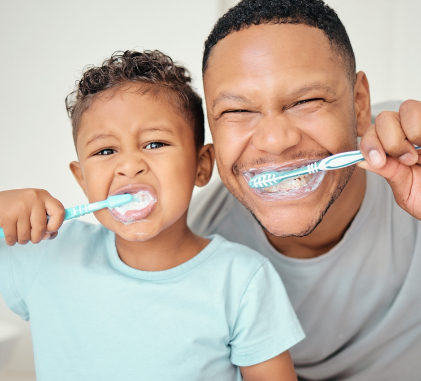
We have all grown up with the classic brushing routine: brush, spit and rinse. But what if I told you that rinsing your mouth immediately after brushing with fluoride toothpaste might be limiting the full benefits of your oral hygiene routine? Leading experts like the American Academy of Pediatric Dentistry (AAPD) and the American Dental Association (ADA) have updated their
guidelines to promote a more effective habit: spit, not rinse.
Why It Matters: The Role of Fluoride in Toothpaste
The primary goal of brushing with toothpaste is to remove plaque and food particles and deliver fluoride to your teeth. Fluoride is a key ingredient because it strengthens enamel, the outer protective layer of your teeth. According to the ADA, fluoride helps by remineralizing weakened areas of enamel and preventing cavities over time (American Dental Association, 2023).
However, when you rinse your mouth immediately after brushing, you wash away a significant portion of the fluoride that was just applied. This reduces its effectiveness because the fluoride doesn’t get enough time to work its magic.
What The Experts Say
The AAPD emphasizes the importance of fluoride in strengthening teeth and reducing decay, especially in children. They recommend that after brushing, children should spit out the excess toothpaste but avoid rinsing with water to allow the fluoride to stay on the teeth longer (American Academy of Pediatric Dentistry, 2023). This approach is equally beneficial for adults.
The ADA similarly suggests this change to your oral hygiene routine. Their research indicates that minimizing rinsing can increase fluoride’s effectiveness in protecting enamel and fighting cavities (American Dental Association, 2023). The ADA encourages a simple shift in your routine: after brushing, spit out the excess toothpaste but skip the rinse with water or mouthwash to allow fluoride to continue working.
What About Mouthwash?
If you’re used to rinsing with a mouthwash after brushing, you might be wondering how to incorporate it. The ADA suggests using mouthwash at a different time, such as after meals or between brushings, to avoid washing away the fluoride from your toothpaste. If your mouthwash contains fluoride, consider using it separately or consult your dentist about the best timing.
Benefits of Not Rinsing After Brushing
- Increased Fluoride Absorption: By not rinsing, fluoride remains on your teeth longer, increasing its ability to penetrate and remineralize enamel.
- Enhanced Cavity Prevention: With fluoride lingering on the teeth, it can better protect enamel and reduce the risk of cavities, as supported by the AAPD and ADA guidelines.
- Stronger Enamel: Long-term exposure to fluoride strengthens enamel, making it more resistant to decay and wear.
Adapting to the Change
For many of us, breaking the rinse habit may feel uncomfortable at first. You might feel like your mouth isn’t completely clean without rinsing. However, this adjustment could lead to healthier teeth in the long run. As both the AAPD and ADA explain, the key is consistency and allowing fluoride the opportunity to work over time.
Takeaway
To maximize the benefits of fluoride toothpaste, experts from both the American Academy of Pediatric Dentistry (AAPD) and the American Dental Association (ADA) recommend spitting out excess toothpaste after brushing, but avoiding a rinse with water. This small change can lead to stronger enamel and better cavity prevention, making it a valuable addition to your oral hygiene routine.
For more detailed guidelines, always consult your dentist or refer to resources from the AAPD and ADA.
Sources:
